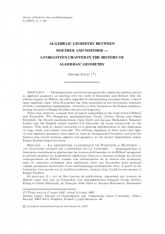La géométrie algébrique de Noether à Noether — un chapitre oublié de l'histoire de la théorie
Algebraic Geometry between Noether and Noether — a forgotten chapter in the history of Algebraic Geometry

- Consulter un extrait
- Année : 1997
- Fascicule : 1
- Tome : 3
- Format : Électronique
- Langue de l'ouvrage :
Anglais - Pages : 1-48
- DOI : 10.24033/rhm.60
Mathématiciens et historiens considèrent en général que les travaux de Kronecker et de Hilbert inaugurent la période moderne de la géométrie algébrique. Mais on a souvent envisagé les articles correspondants de Hilbert comme une reformulation de la théorie des invariants, sujet de caractère nettement plus algébrique, alors que Kronecker était présenté comme promoteur doctrinaire d'une mathématique arithmétisée, finie. À partir de là, l'attention s'est portée sur la tradition italienne, laissant dans l'oubli la voie menant à Emmy Noether.
Et pourtant, il y eut un flux continu de publications, répondant aux travaux de Hilbert aussi bien que de Kronecker. Les mathématiciens hongrois Gyula (Julius) König et József Kürschák, les Français Jules Molk et Jacques Hadamard, Emmanuel Lasker et enfin le professeur de lycée anglais F.S. Macaulay, ont tous publié abondamment sur le sujet. Ces travaux sont étroitement liés à une élaboration progressive des notions d'anneau, de corps, et autres concepts connexes. L'évolution des préoccupations que manifestent ces publications fait ressortir de combien la géométrie algébrique est redevable à ses deux éminents fondateurs, et la façon dont se présentaient les rapports entre algèbre et géométrie dans la période immédiatement antérieure aux débuts de l'œuvre d'Emmy Noether.

